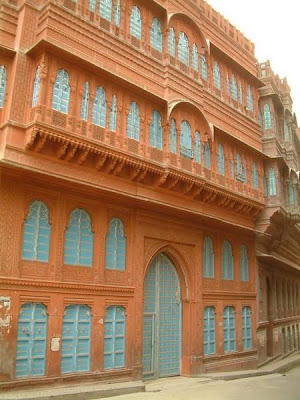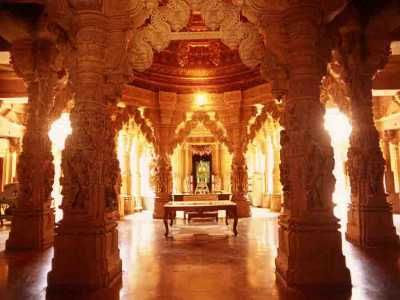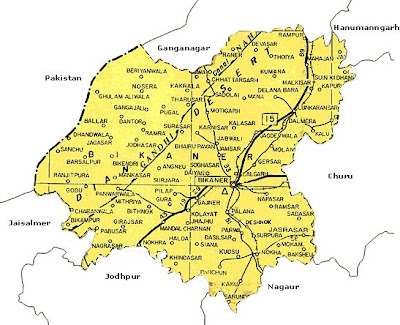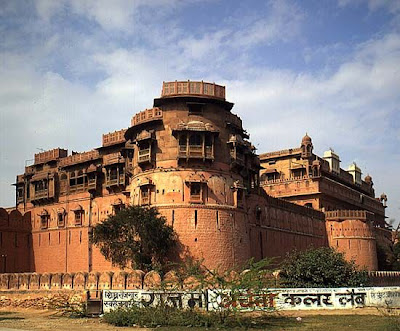
The much anticipated trip to Bikaner turned out to be more than a mere holiday. It was, in the true sense, a brush with royalty. A whiff of the glorious past so permeates this small tourist spot in Rajasthan that it is impossible to not carry its fragrance on your way back.
As you step onto the station and get the feel of the city on the way to Lalgarh Palace, you begin to discern the underlying tranquillity so conspicuous by the near absence of motor vehicles and the usual din and noise. Clean, wide and unbroken roads greet you and beckon you to take a peek at the small city dotted with majestic forts and buildings in red sandstone.
The long driveway takes us into Lalgarh Palace, a part of which has been converted into heritage hotel and the rest are the private chambers of the royalty that still resides there. Behold the peacocks priding in the gardens and you instantly envision queens and princesses in flowing silk strutting past them.
The very first day sees us walk up the par
 apet of Junagarh Fort and into the open courtyard which was setting for the coronation of erstwhile rulers. As we moved from one room to another, crossing long, pillared, corridors, courtyards and narrow and dark stairwells, the magnificence began to overpower. The intricate carvings, the work on ceilings and walls in pure gold, the swing adorned with several dolls on both sides of its poles (the do
apet of Junagarh Fort and into the open courtyard which was setting for the coronation of erstwhile rulers. As we moved from one room to another, crossing long, pillared, corridors, courtyards and narrow and dark stairwells, the magnificence began to overpower. The intricate carvings, the work on ceilings and walls in pure gold, the swing adorned with several dolls on both sides of its poles (the do lls danced when one swayed on it), the motifs from mythology and the life of kings, all reminded us of life in times past.
lls danced when one swayed on it), the motifs from mythology and the life of kings, all reminded us of life in times past.The Baadal Room with its musical instruments, clouds painted on a blue ceiling, and provision for sprinkling water to give the effect of rain in the parched summer months speaks of the luxury that the rulers desired and made possible. The fort displays swords, guns, knives, armour; the Maharaja's personal belongings in his office; his aircraft; palkis; costumes and more. Adjoining the fort is Prachina, the museum showcasing family silver, cutlery, crockery, shringaar knick-knacks and poshak or court dresses. The Sadul museum housed in Lalgarh Palace displays the royal lineage through innumerable photographs and Laxmi Niwas ischock full of trophies of hunts long past...
Amid all this grandeur, what leaves you absolutely mesmerised is the Lake Palace of Gajner, the hunting resort of the Maharajas. The quietude here is deafening, the hospitability unmatched, the ambience perfect for honeymooners. To top it all, we were driven to the adjoining sanctuary in a royal buggy driven by four horses, to see black bucks and dee
 r.
r.The bustling marketplace is as unusual too. We were greeted with respect and offered paan. Colour, striking and splashing, is what grabbed attention. This is what imparts life to arid Rajasthan. And the language. The sweetness and dignity in 'hukum' floors you and the rustic lingo adds flavour to the food too. Gattas, saag, baajre ki roti, lal maas – there is a typical aroma to the cuisine.
Havelis – intricately carved with low doors and decorative windows - are yet another special feature. The thrill of seeing them from a tonga meandering through constricted bylanes is unmatched. Many now lie abandoned, on the verge of collapse. Suddenly in a rare open space a huge temple structure looms large: a 560-year-old Jain temple, the foundation of which was laid in tons of ghee! Intricately carved, the highest pinnacle of this temple gives a splendid view of the city.
To Raiser for a camel ride that turns out to be the most unpalatable of all adventures, not for anything else but the very nature of getting on and off the desert ship. You almost stumble off the hunchback and the ride across the dunes (not too many), leaves you drained, completely. To return to be rejuvenated at Lalgarh!
No comments:
Post a Comment